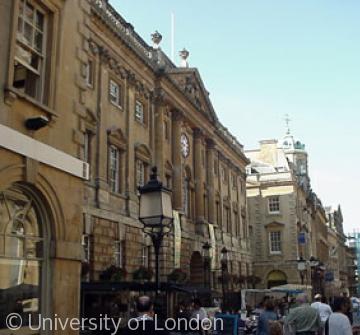Corn Exchange

The Exchange was built in 1741–43 by John Wood the Elder, with carvings by Thomas Paty, replacing the less grand facilities on the site for Bristol's merchants.
When finished in 1743 the Exchange, as planned, had “the outward appearance of one grand structure” and the much-admired exterior remains largely as built today.Internally, however, it consisted of various spaces. On either side of the front entrance in Corn Street were a coffee house and tavern, each of four storeys. Despite its name it was intended for merchants of all types and a number directly involved in the Guinea and West Indian trade used it for business transactions. However, it seems most African and American merchants preferred the more informal atmosphere of the nearby coffee houses.
Above and below the main entrance were rooms designed as strong rooms. Look inside the Corn Exchange to see the plasterwork in the main hall. Above the doors of the main chamber are represented separately the four corners of the world, including Africa, Asia and America, the latter wearing a head-dress of tobacco leaves. On the outside of the building are carvings of African, American, Asian and European figures and animals, again symbols of Bristol's foreign trade.
At the back of the building was a two storey range, consisting of an arcade on the ground floor and a long first-floor room. Below these various elements were cellars. Those below the five houses were each separate; the others were mostly interconnected.
The Nails
Four brass tables are located outside the exchange on Corn Street, probably modelled after mobile tables which were taken to trade fairs and markets. The brass nails, with their flat tops and raised edges which prevent coins from tumbling onto the pavement, were made as convenient tables for merchants to carry out their business.
Exchange Clock
The clock over the old Corn Exchange in Bristol has two minute hands. The black minute hand shows Greenwich Mean Time and the red minute hand shows Bristol time.
Today the Exchange is designated as Grade 1 listed building. Always owned by the City of Bristol, the building has served a variety of purposes, currently housing both offices of the former City Valuer's Department and market traders.









